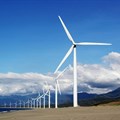According to Dinesh Buldoo, managing director for power at WSP in Africa, the tax incentives for solar and other green energy announced in the 2023 Budget Speech will greatly encourage the adoption of renewable energy in South Africa.

Dinesh Buldoo, managing director for power at WSP in Africa
“South Africa has world-leading and abundant solar and wind resource potential. These incentives should support the growth of the alternative energy sector as a whole and enable it to overcome upfront capital costs on individual projects in favour of long-term gains for the industry and the country,” says Buldoo.
WSP has seen several renewable energy projects, in different regions in Africa, coming through the planning pipeline over the past several years – with evidence of significant investor and developer interest in further projects. The company has also delivered solar and wind projects through the four rounds of the Renewable Energy Independent Power Producer Procurement Programme (REIPPPP).
To truly unlock the potential in the renewables sector – in South Africa and on the African continent as a whole – regulations that enable renewable power generation plants to be built, and legislation and policies that support the growth of the alternative energy sector are needed. Tax incentives are one step towards making these changes, says Buldoo.
“Private sector interest in investing in renewable power assets across Africa has been growing steadily, as the continent offers diverse renewable energy sources ranging from solar and wind to green hydrogen,” he points out. “This latest announcement by the South African government should encourage local investment.”
Distribution contraints
But it’s not as simple as it sounds, Buldoo cautions. “Mitigating against the costs involved, especially in light of the recent volatility in equipment prices, is only one factor here. Getting the excess renewable energy generated by new private installations onto the grid and distributed to where it’s needed is what will make the real impact. Addressing South Africa’s grid constraints, therefore, becomes of even greater importance if the country is to maximise the momentum these incentives could create for renewable energy investment.”
Large-scale solar and wind farms are often located in remote destinations based on where the best solar and wind resources are. This results in these projects being concentrated in specific areas, leading to grid access issues since these areas often have little to no grid capacity available. Though the tax incentives could serve to incentivise rooftop solar installations in more urbanised areas, where grid access may be more readily available, transmission and distribution systems may still be inadequately developed to accept power generated from these installations.
Hannetjie Marais 17 Mar 2023
Renewable Energy Grid Survey
To understand the existing grid constraints better and aid Eskom in its overall grid planning, the South African Photovoltaic Industry Association (Sapvia) and the South Africa Wind Energy Association (Sawea) recently announced the launch of the 2023 South African Renewable Energy Grid Survey in conjunction with Eskom.
“Zayd Vawda, senior renewable energy engineer at WSP in Africa and chairperson of the Sapvia grid access working group, led the development and strategic guidance of the survey,” Buldoo says. “The 2023 version of the survey will account for projects that employ wheeling and has been expanded to capture even more detail per project, which will be invaluable to Eskom’s transmission planning division. It also gives the South African renewable energy industry an opportunity to contribute to national transmission planning and development, which should add value in addressing grid constraints.”
WSP is also assisting the Sapvia/Sawea task team who are leading the coordination of the solar and wind industry input to the new Eskom grid access guidelines. This aims to unblock one of the key challenges facing IPPs in South Africa.
Realising green economy opportunities
Buldoo adds: “We believe that as more renewable power generation plants are built as a result of recent changes in the Electricity Regulations Act, and as businesses begin to leverage the tax incentives announced in the Budget Speech, South Africa will experience intermittent excess energy in the electricity grid,” Buldoo says.
“This will allow the country to begin realising other opportunities, including in the green economy, such as its ambitions in the production and export of green hydrogen.”
“All indications are that by successfully leveraging renewable energy sources, South Africa can benefit greatly from the global drive to achieve certain decarbonisation targets by 2030 and become carbon neutral by 2050. Critically, these benefits will not only be from an environmental point of view, but from an economic and social one as well,” Buldoo concludes.



























![Today, Halo and Demographica announce a new specialist agency, Second Rodeo]], headed up by Mike Stopforth (left). Dean Oelschig, managing partner and founder of Halo (right) says they will work as a group but ultimately, each agency will be an individual specialist](https://biz-file.com/c/2505/772543-64x64.jpg?2)






